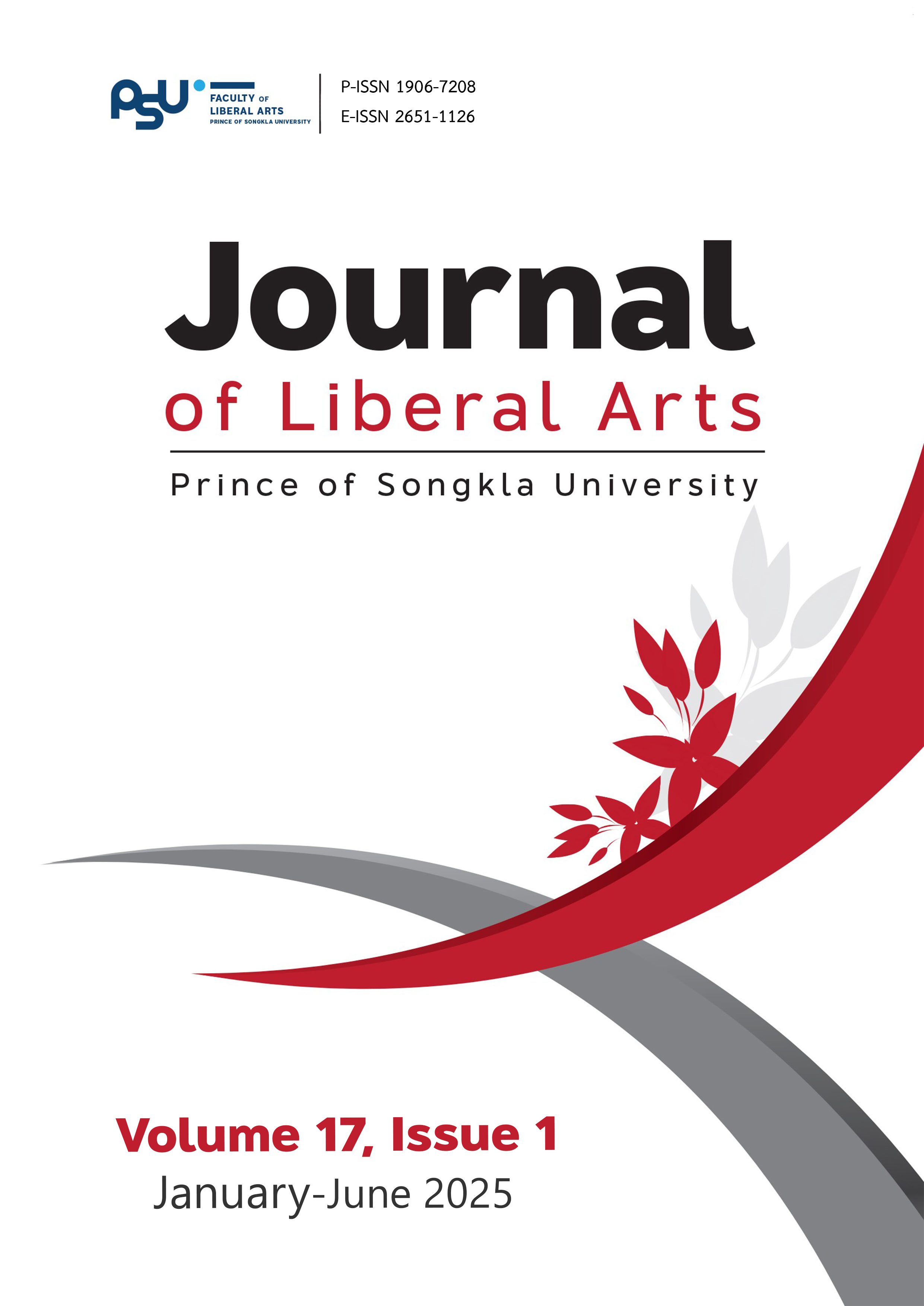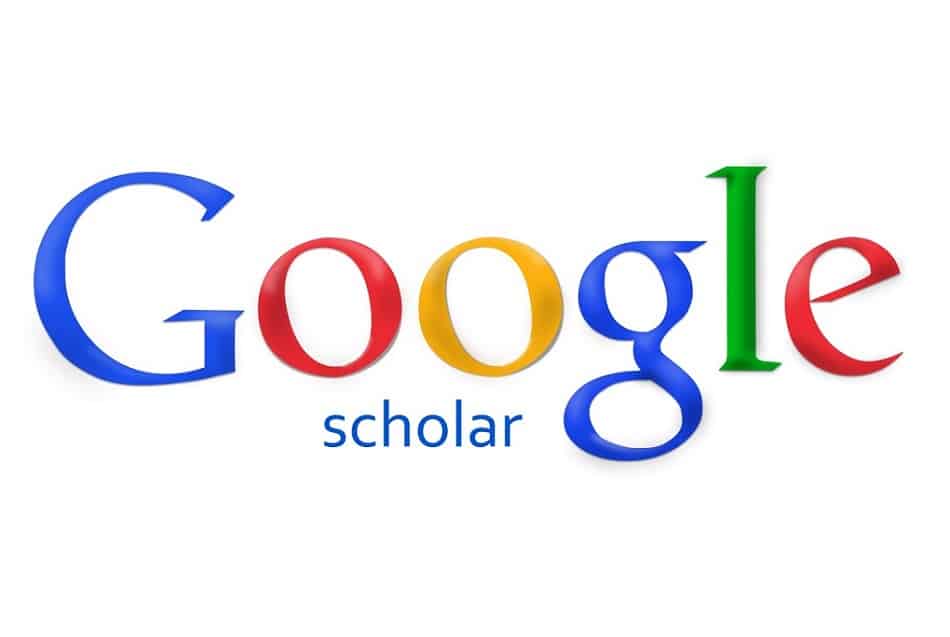Investigating Peer Assessment in Collaborative Writing Among Thai EFL Students: Effects on English Writing Ability
DOI:
https://doi.org/10.14456/jlapsu.2025.3Keywords:
Peer Assessment, Collaborative Writing, EFL High School Students in Thailand, Writing PerformanceAbstract
This study investigated the effectiveness of peer assessment in a collaborative writing approach on English writing performance and examined students’ opinions after receiving the treatment. A total of 36 high school students from a public school in Pathum Thani, Thailand, who enrolled in grade 11, were purposively selected as participants. This study used a mixed-methods approach with an experimental one-group pretest-posttest design. Quantitative data were collected through writing tests administered before and after the treatment, while qualitative data were gathered through a semi-structured interview conducted upon completion of the treatment. The statistical results showed a substantial rise in posttest mean scores compared to pretest mean scores, with an average increase of 3.50 and a 99% confidence interval spanning from 2.25 to 4.25. These results revealed that peer feedback, alongside collaborative writing, significantly improved students' writing capacity. The interview results showed that most students expressed positive opinions toward the treatment, emphasizing its effectiveness in enhancing English writing skills and providing ample opportunities for peer learning and scaffolding during writing lessons. Overall, the findings shed light on the potential of peer assessment in collaborative writing, showing that it significantly helps students compose writing tasks more systematically and chronologically. Students were also able to better understand and apply the linguistic features of paragraph writing, leading to improved writing quality. To further improve these outcomes, future research should ensure adequate time for feedback preparation and provide comprehensive training sessions on co-authoring.
References
Almahasneh, A. M. S., & Abdul-Hamid, S. (2019). The effect of using peer assessment training on writing performance among Arab EFL high school students in Malaysia. Arab World English Journal, 10(1), 105–115. https://dx.doi.org/10.24093/awej/vol10no1.10
Alshuraidah, A., & Storch, N. (2019). Investigating a collaborative approach to peer feedback. ELT Journal, 73(2), 166-174. https://doi.org/10.1093/elt/ccy057
Andrade, H. G. (1997). Understanding Rubrics. Educational Leadership, 54(4), 14-17.
Bathgate, M., Crowell, A., Schunn, C., Cannady, M., & Dorph, R. (2015). The learning benefits of being willing and able to engage in scientific argumentation. International Journal of Science Education, 37(10), 1590–1612. https://doi.org/10.1080/09500693.2015.1045958
Berggren, J. (2015). Learning from giving feedback: A study of secondary-level students. ELT Journal, 69(1), 58–70. https://doi:10.1093/elt/ccu036
Berggren, J. (2019). Writing, reviewing, and revising: Peer feedback in lower secondary EFL classrooms [Unpublished doctoral dissertation]. Stockholm University.
Black, P., Harrison, C., Lee, C., Marshall, B., & Wiliam, D. (2004). The nature and value of formative assessment for learning [Unpublished manuscript]. Educational Testing Service. http://www.kcl.ac.uk/content/1/c4/73/57/formative.pdf.
Bueno-Alastuey, M. C., & Martinez, P. (2017). Collaborative writing in the EFL secondary education classroom comparing triad, pair and individual work. Huarte de San Juan. Filologíay Didáctica de la Lengua, 17, 254–275. https://dialnet.unirioja.es/servlet/articulo?codigo=6408523
Bueno-Alastuey, M. C., Vasseur, R., & Elola, I. (2022). Effects of collaborative writing and peer feedback on Spanish as a foreign language writing performance. Foreign Language Annals, 55(2), 517–539. https://doi.org/10.1111/flan.12611
Chen, W. (2019). An exploratory study on the role of L2 collaborative writing on learners’ subsequent individually composed texts. Asia-Pacific Education Researcher, 28(6), 563-573. https://doi.org/10.1007/s40299-019-00455-3
Chen, W., Liu, D., & Lin, C. (2023). Collaborative peer feedback in L2 writing: Affective, behavioral, cognitive, and social engagement. Frontiers in Psychology, 14, 1-12. https://doi.org/10.3389/fpsyg.2023.1078141
Cheng, X., & Zhang, L. J. (2024). Engaging secondary school students with peer feedback in L2 writing classrooms: A mixed-methods study. Studies in Educational Evaluation, 81, Article 101337. https://doi.org/10.1016/j.stueduc.2024.101337
Cohen, J. (1960). A coefficient of agreement for nominal scales. Educational and Psychological Measurement, 20(1), 37–46. https://doi.org/10.1177/001316446002000104
Cohen, J. (1998). Statistical Power Analysis for the Behavioral Sciences (2nd ed.). Lawrence Erlbaum Associates.
Damayanti, I. L., Abdurahman, N. H., & Wulandari, L. (2020). Collaborative writing and peer feedback practices using Google Docs. In Proceedings of the Thirteenth Conference on Applied Linguistics (pp. 228–233). Atlantis Press.
Earl, L. M. (2013). Assessment as learning: Using classroom assessment to maximize student learning. Corwin Press.
Erlingsson, C., & Brysiewicz, P. (2017). A hands-on guide to doing content analysis. African Journal of Emergency Medicine: Revue Africaine De La Medecine D'urgence, 7(3), 93–99. https://doi.org/10.1016/j.afjem.2017.08.001
Faggosa, Y. (2015). The contribution of Facebook groups in improving English as a foreign language writing skill of 9th grade female students at public schools in Jordan. Research on Humanities and Social Sciences, 5(24), 94-98.
Forman, R. (2016). First and second language use in Asian EFL (Vol. 49). Multilingual Matters.
Gielen, M., & De Wever, B. (2015). Structuring the peer assessment process: A multilevel approach for the impact on product improvement and peer feedback quality. Journal of Computer Assisted Learning, 31(5), 435–449. https://doi.org/10.1111/jcal.12096
Gil, M., & Kim, S. (2022). Feasibility and preliminary efficacy of a new online self-help intervention for depression among Korean college students’ families. International Journal of Environmental Research and Public Health, 19(4), Article 2142. https://doi.org/10.3390/ijerph19042142
Hattie, J., & Timperley, H. (2007). The power of feedback. Review of Educational Research, 77(1), 81–112. https://doi.org/10.3102/003465430298487
Hu, G., & Choo, L. (2016). The impact of disciplinary background and teaching experience on the use of evaluative language in teacher feedback. Teachers and Teaching: Theory and Practice, 22(3), 329–49. https://doi.org/10.1080/13540602.2015.1058591
Hyland K., and Hyland, F. (2006). Contexts and issues in feedback on L2 writing: An introduction. In K. Hyland & F. Hyland (Eds.), Feedback in second language writing: Contexts and issues (pp. 1-19). Cambridge University Press.
Iwashita, N., & Dao, P. (2021). Peer feedback in second language oral interaction. In H. Nassaji & E. Kartchava (Eds.), The Cambridge handbook of corrective feedback in second language learning and teaching (pp. 275–299). Cambridge University Press.
Jacobs, H. L., Zingraf, S. A., Wormuth, D. R., Hartfiel, V. F., & Hughey, J. B. (1981). Testing ESL Composition: A Practical Approach. Newbury House.
Khodabakhshzadeh, H., & Samadi, F. (2017). The effect of collaborative writing on Iranian EFL learners’ task achievement in writing and their perception. International Journal of Applied Linguistics & English Literature, 7(1), 113-119. http://dx.doi.org/10.7575/aiac.ijalel.v.7n.1p.113
Lakens, D. (2013). Calculating and reporting effect sizes to facilitate cumulative science: A practical primer for t-tests and ANOVAs. Frontiers in Psychology, 4, Article 863. https://doi.org/10.3389/fpsyg.2013.00863
Lam, R. (2010). A peer review training workshop: Coaching students to give and evaluate peer feedback. TESL Canada Journal, 27(2), 114-124. https://doi.org/10.18806/tesl.v27i2.1052
Lange, R. T. (2011). Inter-rater reliability. In: J. S. Kreutzer, J. DeLuca, & B. Caplan (Eds.), Encyclopedia of Clinical Neuropsychology. Springer, New York, NY. https://doi.org/10.1007/978-0-387-79948-3_1203
Lee, I. (2007). Feedback in Hong Kong secondary writing classrooms: Assessment for learning or assessment of learning. Assessing Writing, 12(3), 180–198. https://doi.org/10.1016/j.asw.2008.02.003
Lee, I. (2017). Classroom assessment and feedback in L2 school contexts. Springer.
Li, M., & Zhu, W. (2013). Patterns of computer-mediated interaction in small writing groups using wikis. Computer Assisted Language Learning, 26, 61–82. https://doi.org/10.1080/09588221.2011.631142
Lindeman, E. (1982). A rhetoric for writing teachers. Oxford University Press.
Liu, J., & Hansen, E. J. (2002). Peer response in second language writing classrooms. University of Michigan Press.
Lu, J. Y., & Law, N. (2012). Online peer assessment: Effects of cognitive and affective feedback. Instructional Science, 40, 257–275. https://doi.org/10.1007/s11251-011-9177-2
Mamarajabova, S. D., & Bakhriddinova, Y. B. (2023). Some difficulties on teaching writing for EFL students. JournalNX - A Multidisciplinary Peer Reviewed Journal, 9(2), 149-152. https://doi.org/10.17605/OSF.IO/NHZ6M
McDonough, K., Ammar, A., & Sellami, A. (2021). L2 French students’ conversations during interactive writing tasks and their interaction mindset. Foreign Language Annals, 55(1), 222–236. https://doi.org/10.1111/flan.12594
Mendonça, C. O., & Johnson, K. E. (1994). Peer review negotiations: Revision activities in ESL writing instruction. TESOL Quarterly, 28(4), 745–769. https://doi.org/10.2307/3587558
Min, H. T. (2005). Training students to become successful peer reviewers. System, 33(2), 293-308. https://doi.org/10.1016/j.system.2004.11.003
Niu, R. (2009). Effect of task-inherent production modes on EFL learners’ focus on form. Language Awareness, 18(3–4), 384–402. https://doi.org/10.1080/09658410903197256
Nunan, D. (2003). Practical English language teaching. McGraw-Hill.
Onozawa, C. (2010). A study of the process writing approach: A suggestion for an eclectic writing approach. Research Note, 10, 153–163. https://core.ac.uk/download/pdf/141876629.pdf
Prasobdee, S. (2021). Peer feedback Facebook approach on English writing skills of grade 7 students, Samutprakarn. NET: New Educational Review, 15(1), 36-40.
Prompan, J., & Piamsai, C. (2024). The effects of peer feedback and self-regulated learning on Thai EFL students’ writing ability and self-regulation. LEARN Journal: Language Education and Acquisition Research Network, 17(1), 100-132. https://so04.tci-thaijo.org/index.php/LEARN/article/view/270378
Reid, J. M. (1993). Teaching ESL writing. Prentice-Hall.
Schellekens, L. H., Bok, H. G. J., de Jong, L. H., van der Schaaf, M. F., Kremer, W. D. J., & van der Vleuten, C. P. M. (2021). A scoping review on the notions of Assessment as Learning (AaL), Assessment for Learning (AfL), and Assessment of Learning (AoL). Studies in Educational Evaluation, 71, 1-15. https://doi.org/10.1016/j.stueduc.2021.101094
Serafini, F. (2001). Three paradigms of assessment: Measurement, procedure, and inquiry. The Reading Teacher, 54(4), 384-393. http://www.jstor.org/stable/20204924
Sitthiworachart, J., & Joy, M. (2004). The evaluation of students’ marking in web‐based peer assessment of learning computer programming. In Proceedings of the International Conference on Computers in Education (ICCE 2004) (pp. 1153‐1163). Melbourne, Australia.
Snyder, D. W., Nielson, R. P., & Kurzer, K. (2016). Foreign language writing fellows programs: A model for improving advanced writing skills. Foreign Language Annals, 49(4), 750–771. https://doi.org/10.1111/flan.12231
Solhi, M., & Eginli, I. (2020). The effect or recorded oral feedback on EFL learners’ writing. Journal of Language and Linguistic Studies, 16(1), 1-13. https://doi.org/10.17263/jlls.712628
Son, H. (2021). The effects of simulation problem-based learning on the empathy, attitudes toward caring for the elderly, and team efficacy of undergraduate health profession students. International Journal of Environmental Research and Public Health, 18(18), Article 9658. https://doi.org/10.3390/ijerph18189658
Storch, N. (2002). Patterns of interaction in ESL pair work. Language Learning, 52(1), 119–158. https://doi.org/10.1111/1467-9922.00179
Storch, N. (2005). Collaborative writing: Product, process, and students’ reflections. Journal of Second Language Writing, 14(3), 153-173. https://doi.org/10.1016/j.jslw.2005.05.002
Storch, N. (2019). Collaborative writing as peer feedback. In K. Hyland & F. Hyland (Eds.), Feedback in second language writing: Contexts and issues (pp.143–162). Cambridge University Press.
Strobl, C. (2014). Affordances of Web 2.0 technologies for collaborative advanced writing in a foreign language. Calico Journal, 31(1), 1–18. https://doi.org/10.11139/cj.31.1.1-25
Swain, M., & Lapkin, S. (1998). Interaction and second language learning: two adolescent French immersion students working together. Modern Language Journal, 82, 320–337. https://doi.org/10.1111/j.1540-4781.1998.tb01209.x
Taber, K. S. (2018). The use of Cronbach’s alpha when developing and reporting research instruments in science education. Research in Science Education, 48(6), 1273–1296. https://doi.org/10.1007/s11165-016-9602-2
Tian, J. (2011). The effects of peer editing versus co-writing on writing in Chinese-as-a-foreign language [Unpublished doctoral dissertation]. University of Victoria.
Topping, K. J. (2009). Peer assessment. Theory Into Practice, 48(1), 20–27. https://doi.org/10.1080/00405840802577569
Watanabe, Y., & Swain, M. (2007). Effects of proficiency differences and patterns of pair interaction on second language learning: Collaborative dialogue between adult ESL learners. Language Teaching Research, 11(2), 121–142. https://doi.org/10.1177/136216880607074599
Widiawati, U., & Cahyono, B. Y. (2001). The teaching of EFL writing in the Indonesian context: The state of the art. Jurnal Ilmu Pendidikan, 13(3), 139–150. https://doi.org/10.17977/jip.v13i3.40
Wonglakorn, P., & Deerajviset, P. (2023). The effects of collaborative process writing approach on Thai EFL secondary school students’ writing skills. LEARN Journal: Language Education and Acquisition Research Network, 16(1), 495–522. https://so04.tci-thaijo.org/index.php/LEARN/article/view/263454
Wu, S. R. (2007). Effects of group composition in collaborative learning of EFL writing. In C. Stephanidis (Ed.), Universal access in human-computer interaction. Applications and services. UAHCI 2007. Lecture notes in computer science (Vol. 4556). Springer. https://doi.org/10.1007/978-3-540-73283-9_91
Yarandi, H. N. (1996). Hypothesis testing. Clinical Nurse Specialist CNS, 10(4), 186–188. https://doi.org/10.1097/00002800-199607000-00009
Yu, S. (2024). Peer assessment in writing instruction. Cambridge University Press.
Yu, S., & Lee, I. (2016). Peer feedback in second language writing (2005–2014). Language Teaching, 49(4), 461–493. https://doi.org/10.1017/S0261444816000161
Zhang, M. (2018). Collaborative writing in the EFL classroom: The effects of L1 and L2 use. System, 76, 1-12. https://doi.org/10.1016/j.system.2018.04.009
Downloads
Published
How to Cite
Issue
Section
License
Copyright (c) 2025 sunai singtong, Setthawit Sinchai, Willard Jeff Villablanca Pada

This work is licensed under a Creative Commons Attribution-NonCommercial-NoDerivatives 4.0 International License.
The authors retain the copyright to their article but the Journal of Liberal Arts, Prince of Songkla University reserves the exclusive rights to first publication.




